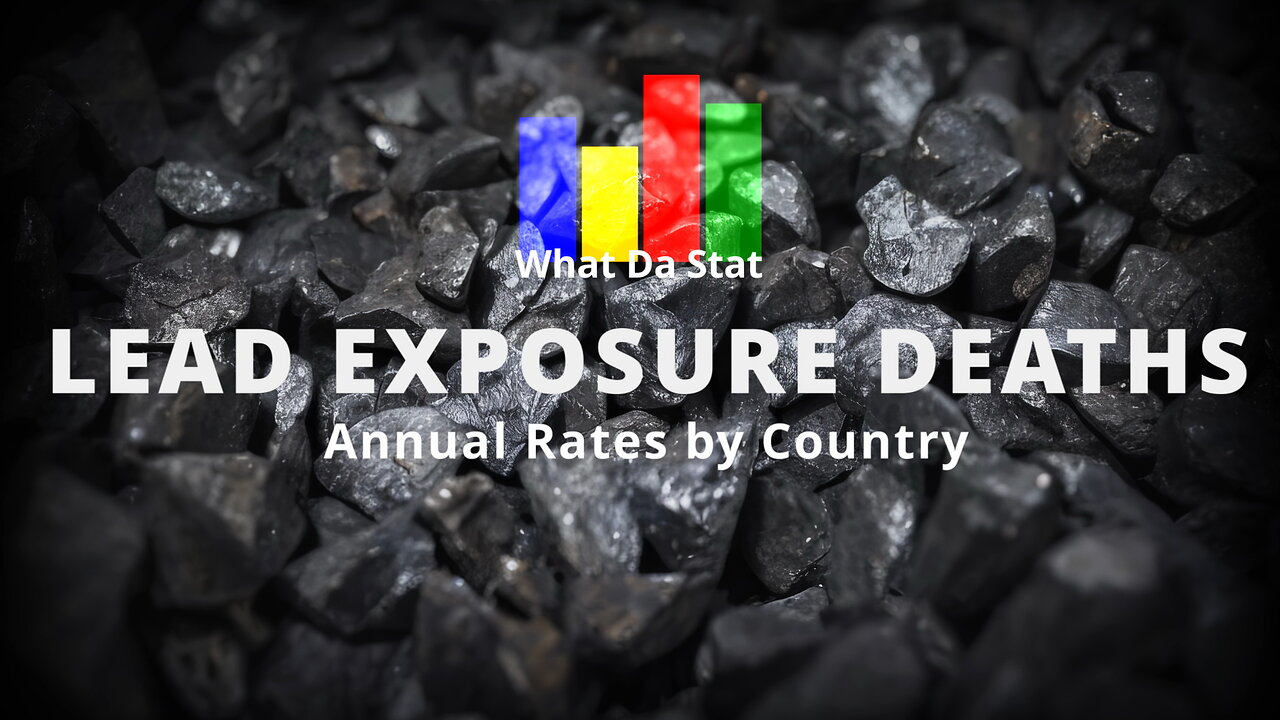Premium Only Content

Deaths Rates from LEAD Exposure by Country and World
This bar chart race shows the annual death rates from lead exposure by country and world, from 1990 to 2019, per 100,000.
Lead, a highly toxic heavy metal, has been used in various industrial and household applications for centuries, but its adverse health effects have only come to light in recent decades. Tragically, exposure to lead continues to claim lives, affecting populations across the globe, irrespective of geographical boundaries.
Causes of Lead Exposure:
Lead exposure primarily occurs through ingestion, inhalation, or skin contact with lead-based products or contaminated substances. Some common causes of lead exposure include:
Paint and Dust: In the past, lead-based paint was widely used, and older buildings still contain layers of lead paint that can deteriorate over time, releasing lead dust into the air. Children living in such environments are particularly vulnerable to lead poisoning when they inhale or ingest this dust during play.
Drinking Water: Lead can leach into drinking water from old plumbing systems, lead pipes, or fixtures made with lead solder. Prolonged consumption of contaminated water can lead to severe health consequences.
Occupational Exposure: Workers in industries like mining, battery manufacturing, and recycling are at risk of lead exposure due to their proximity to lead-containing materials or processes.
Soil Contamination: Lead particles from industrial activities, emissions, or leaded gasoline can contaminate soil. This contamination can pose a threat, especially in urban areas or near industrial sites.
Geographical Distribution:
Lead exposure is not limited to a specific region but can be found across the globe. However, the prevalence and severity of lead poisoning vary based on socio-economic factors, industrialization, and regulation. Some regions are disproportionately affected:
Developing Nations: Many low and middle-income countries lack stringent regulations on lead usage and disposal, leading to higher exposure levels. Inadequate healthcare facilities may also contribute to higher mortality rates in affected areas.
Industrial Hubs: Regions with a history of heavy industries, such as mining, smelting, and manufacturing, may have elevated lead levels in their environment, impacting the health of local residents.
Urban Centers: In densely populated urban areas, aging infrastructure and buildings with lead-based paint can exacerbate the risk of exposure, especially for children living in poorly-maintained housing.
Impact on Health:
Lead exposure can have severe consequences for human health. Children and pregnant women are particularly vulnerable, as lead can hinder cognitive development, cause learning disabilities, and impair neurological functions. Adults can experience cardiovascular issues, kidney damage, and reproductive problems due to lead exposure. In extreme cases, lead poisoning can be fatal.
Prevention and Awareness:
Addressing deaths caused by lead exposure requires a multi-faceted approach:
Regulation: Governments must enforce strict regulations on lead usage in industries, paints, and products. Additionally, monitoring water quality and addressing lead contamination in old infrastructure is crucial.
Public Awareness: Raising awareness about lead exposure, its sources, and preventive measures is vital in empowering communities to protect themselves.
Remediation: Remediation efforts should focus on cleaning up lead-contaminated sites and promoting lead-safe practices in construction and renovation projects.
Health Interventions: Timely medical interventions, such as chelation therapy for severe cases of lead poisoning, can save lives and reduce long-term health impacts.
In conclusion, the tragic deaths caused by lead exposure remain a pressing global issue. The indiscriminate nature of this toxic metal demands collective efforts from governments, industries, healthcare professionals, and communities alike to mitigate its deadly effects. By prioritizing prevention, regulation, and education, we can hope for a future where lead exposure becomes a distant memory, sparing countless lives from its toxic grip.
Source: Global Burden of Disease Collaborative Network. Global Burden of Disease Study 2019 (GBD 2019) Results. Seattle, United States: Institute for Health Metrics and Evaluation (IHME), 2021.
Music: Darren Curtis - Predator or Prey
https://soundcloud.com/desperate-measurez/dark-chimes-and-vocals-predator-or-prey-royalty-free-horror-theme
Data visualization created with flourish.studio and AI
-
 3:51:18
3:51:18
tacetmort3m
1 day ago🔴 LIVE - (MERRY CHRISTMAS) TIME TO SPREAD DEMOCRACY - HELLDIVERS 2 OMENS OF TYRANNY
37.6K2 -
 2:46
2:46
BIG NEM
14 hours agoDiscovering RAKIJA: The Holy Liquer of the Balkans
23.5K2 -
 1:11:38
1:11:38
Film Threat
19 hours agoCHRISTMAS DAY CHILL STREAM WITH CHRIS GORE | Hollywood on the Rocks
143K31 -
 14:22:40
14:22:40
The Quartering
1 day agoYule Log Christmas MAGA Edition With Memes! Come Hang Out!
234K29 -
 38:41
38:41
MYLUNCHBREAK CHANNEL PAGE
1 day agoTimeline Begins in 1800? - Pt 1 & 2
113K66 -
 1:23:41
1:23:41
Game On!
1 day ago $13.97 earnedNetflix NFL Christmas Games Preview and Predictions!
97.4K12 -
 2:05:07
2:05:07
Darkhorse Podcast
1 day agoWhy Trump Wants Greenland: The 257th Evolutionary Lens with Bret Weinstein and Heather Heying
325K901 -
 8:50:58
8:50:58
Right Side Broadcasting Network
1 day ago🎅 LIVE: Tracking Santa on Christmas Eve 2024 NORAD Santa Tracker 🎅
422K69 -
 2:48
2:48
Steven Crowder
1 day agoCROWDER CLASSICS: What’s This? | Nightmare Before Kwanzaa (Nightmare Before Christmas Parody)
369K13 -
 33:49
33:49
Quite Frankly
1 day agoThe Christmas Eve Midnight Telethon
151K30